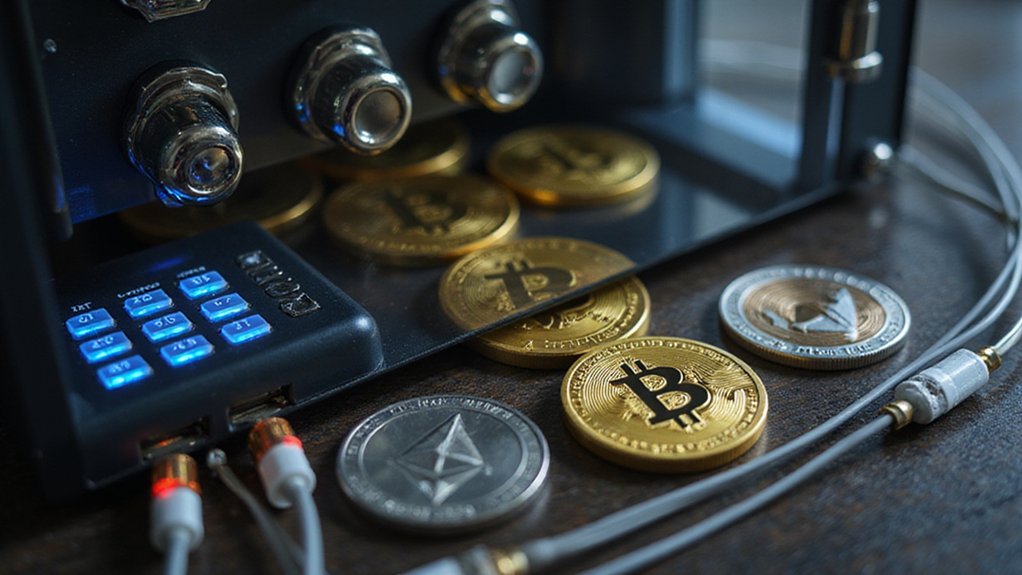Ethereum gas fees represent the network’s computational toll system, where users pay validators in ETH for processing transactions—whether transferring tokens or executing smart contracts. These fees comprise a base fee (which gets burned, creating deflationary pressure) and a priority tip that incentivizes faster processing during network congestion. The cost equals gas units consumed multiplied by the current Gwei price, with complex operations naturally demanding higher fees than simple transfers. Understanding the nuanced mechanics reveals optimization strategies for maneuvering this digital economy.

The peculiar alchemy of Ethereum’s gas fee system transforms computational effort into cold, hard ETH—a mechanism that simultaneously powers the world’s second-largest blockchain while occasionally charging users the equivalent of a decent meal for the privilege of moving twenty dollars’ worth of tokens.
The digital toll booth of decentralized finance, where moving money costs money and computational dreams meet economic reality.
These gas fees represent charges for computational effort on Ethereum, paid to validators who maintain network security and efficiency across all interactions, from simple transfers to complex smart contract executions.
The calculation mechanism operates through a deceptively straightforward formula: gas fee equals units of gas used multiplied by the sum of base fee plus priority fee.
Gas limits establish the maximum units a user willingly spends per transaction, while gas prices (typically denominated in Gwei, where one Gwei equals 0.000000001 ETH) determine cost per unit.
The base fee, set by protocol through EIP-1559, adjusts per block and gets burned—a deflationary mechanism that removes ETH from circulation.
Priority fees represent user-chosen tips to validators for expedited processing, creating a fascinating auction system where urgency commands premium pricing.
Network congestion drives the primary cost determinant, with high demand inflating fees substantially.
Transaction complexity matters equally—executing smart contracts requires considerably more computational resources than basic transfers, translating directly into higher costs.
The Ethereum Virtual Machine processes every operation, consuming gas universally across decentralized applications, making ETH the mandatory currency even for moving alternative tokens like DAI. Smart contracts, typically written in Solidity, serve as immutable digital agreements that execute the business logic underlying these gas-consuming operations. After the proof-of-stake transition in 2022, a portion of collected gas fees now specifically rewards ETH stakers alongside validators for their network participation.
Validators receive gas fees as rewards, naturally prioritizing transactions offering higher tips while ensuring network security by imposing costs on each action.
This economic design deters spam and malicious behavior through financial consequences. Ethereum’s protocol enforces gas fees regardless of whether transactions succeed or fail, ensuring computational resources are paid for even when operations encounter errors or insufficient funds.
The evolution from Ethereum’s original simple gas limit multiplication system to EIP-1559’s dual-fee structure improved predictability while reducing volatility.
Users seeking relief from astronomical fees employ various strategies: timing transactions during low-congestion periods, utilizing Layer 2 solutions like rollups, exploring alternative chains such as Polygon or Avalanche, optimizing gas limits and priority fees, or designing more efficient smart contracts.
Despite these workarounds, gas fees remain an inescapable reality of Ethereum’s economic architecture—a necessary evil that keeps the network secure while occasionally testing users’ financial patience.
Frequently Asked Questions
Can I Get a Refund if My Ethereum Transaction Fails?
Ethereum’s blockchain architecture makes transaction refunds remarkably elusive—gas fees vanish permanently once consumed, regardless of transaction success.
While centralized exchanges occasionally offer remediation for system-related failures (assuming users can prove exchange culpability), the decentralized network itself provides no recourse.
Recipients might voluntarily return funds, though expecting such magnanimity borders on financial naïveté.
Smart contract failures represent particularly cruel ironies: users lose gas while achieving nothing.
Why Do Gas Fees Spike During Weekends and Holidays?
Contrary to the questioner’s premise, gas fees typically *decline* during weekends and holidays due to reduced institutional trading activity and lower network demand.
While retail investors might assume increased leisure-time trading drives congestion, professional traders—who generate substantial transaction volume—largely operate during business hours.
The notable exceptions occur when weekend NFT drops or DeFi events coincidentally align with holidays, creating temporary spikes that belie the general pattern.
Do All Ethereum Wallets Calculate Gas Fees the Same Way?
Ethereum wallets employ surprisingly varied approaches to gas fee calculations, despite operating on the same underlying network.
While most default to 21,000 gas units for ETH transfers, they differ substantially in price estimation algorithms—some use real-time APIs, others rely on cached data.
User interfaces range from transparent breakdowns showing base fees and tips to simplistic “slow/normal/fast” options, creating particularly different experiences for identical transactions.
Can I Set a Maximum Limit on Gas Fees per Transaction?
Users can indeed set maximum gas fee limits per transaction through wallet settings, though this seemingly straightforward feature carries notable risks.
While most wallets offer “custom” or “adjustable” fee options, setting limits too conservatively may result in transactions languishing unconfirmed—or worse, failing entirely.
During network congestion, validators naturally prioritize higher-fee transactions, leaving frugal users watching their carefully budgeted transfers gather digital dust in the mempool.
How Do Layer 2 Solutions Affect Ethereum Mainnet Gas Prices?
Layer 2 solutions create a fascinating paradox: they simultaneously reduce mainnet congestion while generating sustained fee revenue through security postings.
By bundling thousands of transactions off-chain, L2s decrease competition for mainnet block space, theoretically lowering gas prices.
However, the relationship proves more nuanced—mainnet continues experiencing price spikes from direct transactions, while validators benefit from consistent L2 bundling fees, creating an unexpectedly symbiotic economic relationship.









